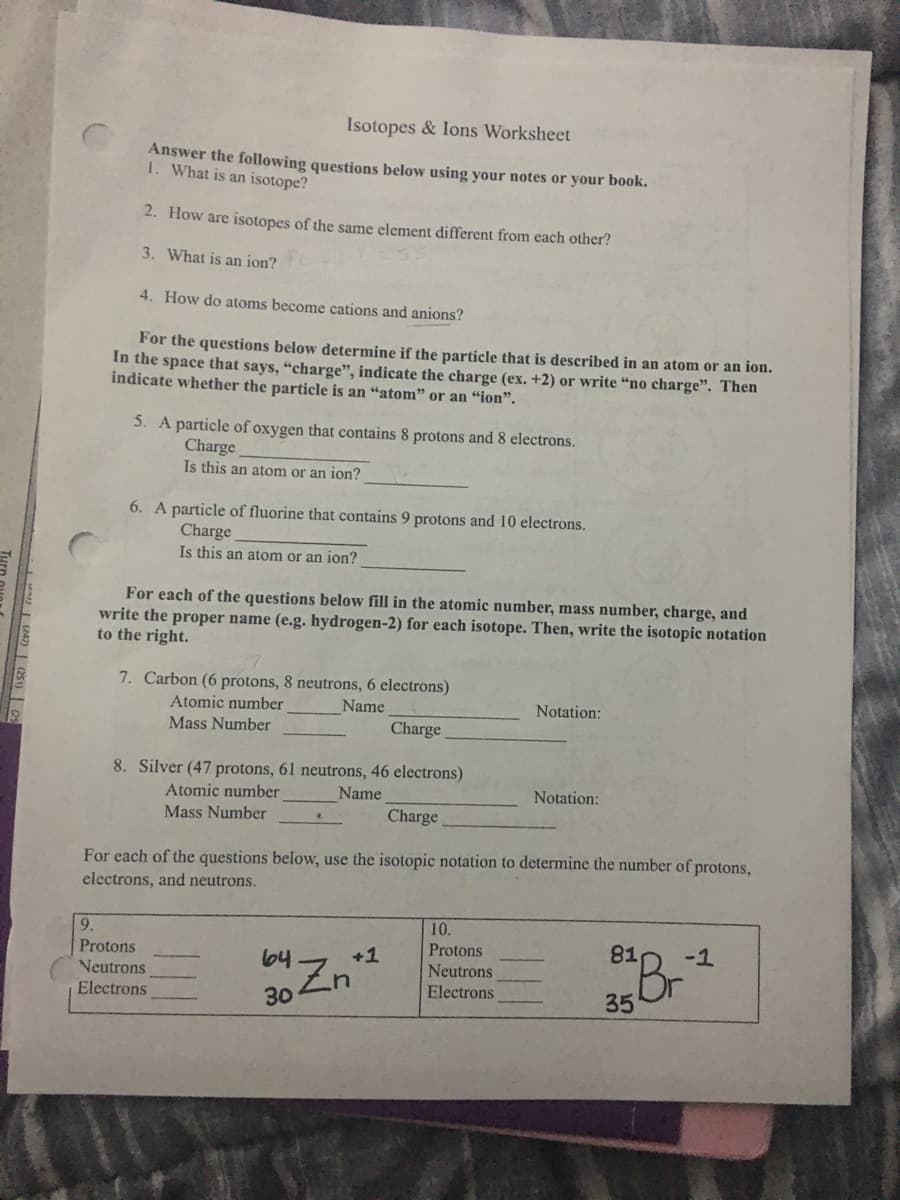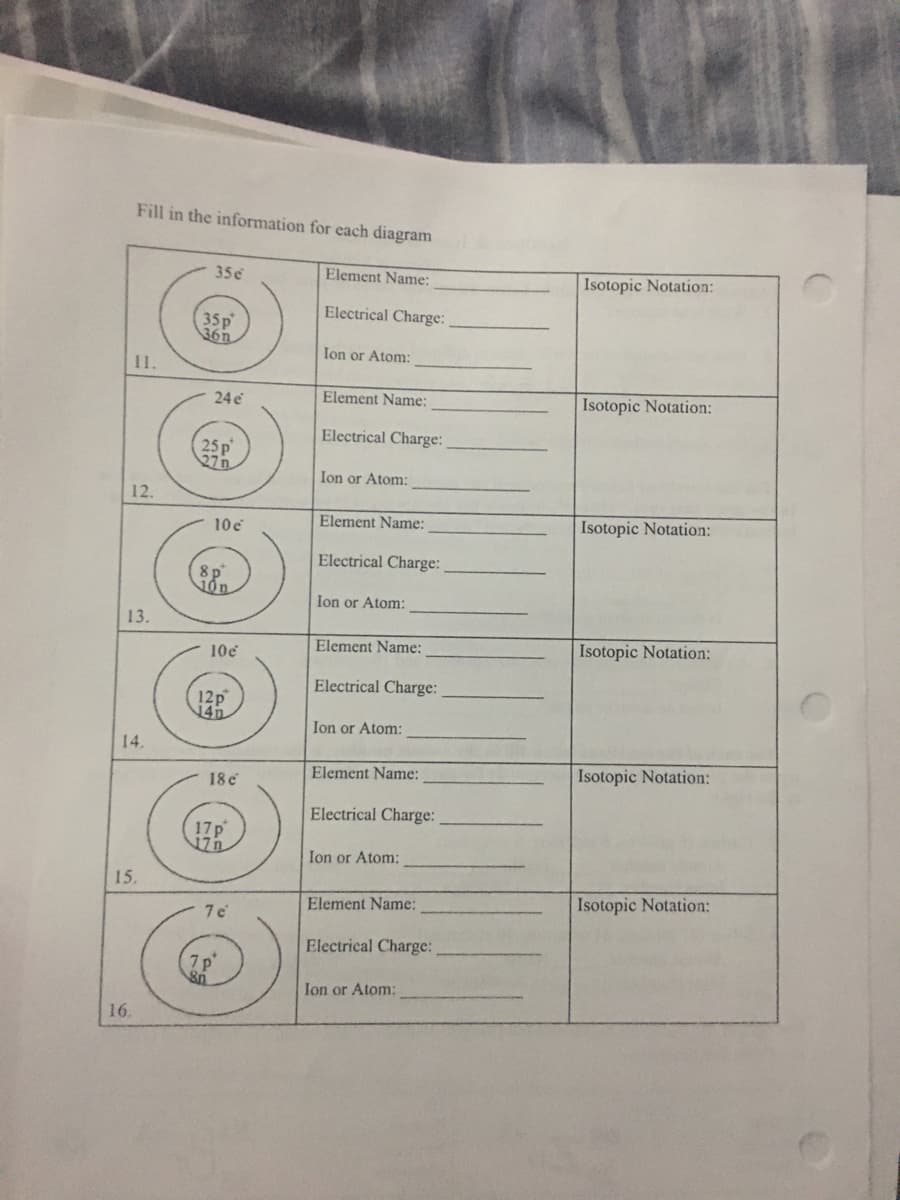Isotopes & lons Worksheet Answer the following questions below using your notes or your book. 1. What is an isotope? 2. How are isotopes of the same element different from each other? 3. What is an ion? 4. How do atoms become cations and anions? For the questions below determine if the particle that is described in on In the snace that
Isotopes & lons Worksheet Answer the following questions below using your notes or your book. 1. What is an isotope? 2. How are isotopes of the same element different from each other? 3. What is an ion? 4. How do atoms become cations and anions? For the questions below determine if the particle that is described in on In the snace that
World of Chemistry, 3rd edition
3rd Edition
ISBN:9781133109655
Author:Steven S. Zumdahl, Susan L. Zumdahl, Donald J. DeCoste
Publisher:Steven S. Zumdahl, Susan L. Zumdahl, Donald J. DeCoste
Chapter3: Chemical Foundations: Elements, Atoms, And Ions
Section: Chapter Questions
Problem 17A
Related questions
Concept explainers
Atomic Structure
The basic structure of an atom is defined as the component-level of atomic structure of an atom. Precisely speaking an atom consists of three major subatomic particles which are protons, neutrons, and electrons. Many theories have been stated for explaining the structure of an atom.
Shape of the D Orbital
Shapes of orbitals are an approximate representation of boundaries in space for finding electrons occupied in that respective orbital. D orbitals are known to have a clover leaf shape or dumbbell inside where electrons can be found.
Question

Transcribed Image Text:Isotopes & lons Worksheet
Answer the following questions below using your notes or your book.
1. What is an isotope?
2. How are isotopes of the same element different from each other?
3. What is an ion?
4. How do atoms become cations and anions?
For the questions below determine if the particle that is described in an atom or an ion.
In the space that says, “charge", indicate the charge (ex. +2) or write “no charge". Then
indicate whether the particle is an "atom" or an “ion".
5. A particle of oxygen that contains 8 protons and 8 electrons.
Charge
Is this an atom or an ion?
6. A particle of fluorine that contains 9 protons and 10 electrons.
Charge
Is this an atom or an jon?
For each of the questions below fill in the atomic number, mass number, charge, and
write the proper name (e.g. hydrogen-2) for each isotope. Then, write the isotopic notation
to the right.
7. Carbon (6 protons, 8 neutrons, 6 electrons)
Atomic number
Name
Notation:
Mass Number
Charge
8. Silver (47 protons, 61 neutrons, 46 electrons)
Atomic number
Name
Notation:
Mass Number
Charge
For each of the questions below, use the isotopic notation to determine the number of protons,
electrons, and neutrons.
10.
9.
Protons
81
-1
Protons
Neutrons
Electrons
64-7
+1
Neutrons
Electrons
Br
35
30

Transcribed Image Text:Fill in the information for each diagram
35e
Element Name:
Isotopic Notation:
Electrical Charge:
35p
36n
Ion or Atom:
11.
24 e
Element Name:
Isotopic Notation:
Electrical Charge:
25 p
Ion or Atom:
12.
Element Name:
Isotopic Notation:
10e
Electrical Charge:
Ion or Atom:
13.
Element Name:
Isotopic Notation:
10e
Electrical Charge:
12p
14n
Ion or Atom:
14.
Element Name:
Isotopic Notation:
18 c
Electrical Charge:
17p
17n
Ion or Atom:
15.
Element Name:
Isotopic Notation:
Electrical Charge:
7p°
Ion or Atom:
16.
Expert Solution
This question has been solved!
Explore an expertly crafted, step-by-step solution for a thorough understanding of key concepts.
This is a popular solution!
Trending now
This is a popular solution!
Step by step
Solved in 2 steps with 2 images

Knowledge Booster
Learn more about
Need a deep-dive on the concept behind this application? Look no further. Learn more about this topic, chemistry and related others by exploring similar questions and additional content below.Recommended textbooks for you

World of Chemistry, 3rd edition
Chemistry
ISBN:
9781133109655
Author:
Steven S. Zumdahl, Susan L. Zumdahl, Donald J. DeCoste
Publisher:
Brooks / Cole / Cengage Learning

Introductory Chemistry: An Active Learning Approa…
Chemistry
ISBN:
9781305079250
Author:
Mark S. Cracolice, Ed Peters
Publisher:
Cengage Learning

Introductory Chemistry: A Foundation
Chemistry
ISBN:
9781337399425
Author:
Steven S. Zumdahl, Donald J. DeCoste
Publisher:
Cengage Learning

World of Chemistry, 3rd edition
Chemistry
ISBN:
9781133109655
Author:
Steven S. Zumdahl, Susan L. Zumdahl, Donald J. DeCoste
Publisher:
Brooks / Cole / Cengage Learning

Introductory Chemistry: An Active Learning Approa…
Chemistry
ISBN:
9781305079250
Author:
Mark S. Cracolice, Ed Peters
Publisher:
Cengage Learning

Introductory Chemistry: A Foundation
Chemistry
ISBN:
9781337399425
Author:
Steven S. Zumdahl, Donald J. DeCoste
Publisher:
Cengage Learning


Chemistry & Chemical Reactivity
Chemistry
ISBN:
9781337399074
Author:
John C. Kotz, Paul M. Treichel, John Townsend, David Treichel
Publisher:
Cengage Learning

Chemistry & Chemical Reactivity
Chemistry
ISBN:
9781133949640
Author:
John C. Kotz, Paul M. Treichel, John Townsend, David Treichel
Publisher:
Cengage Learning